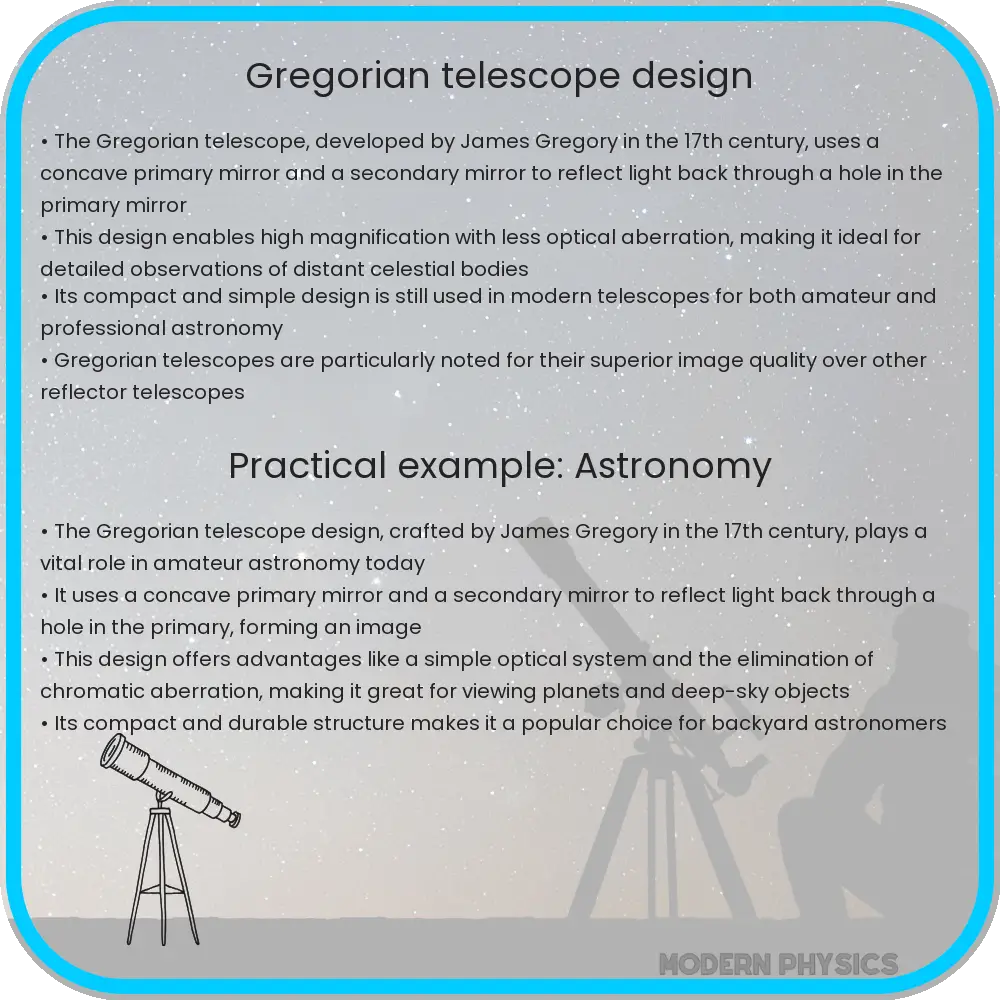Discover the innovative design of the Gregorian Telescope: a masterpiece of optical precision that enhances clarity and simplifies astronomy for enthusiasts.

Exploring the Gregorian Telescope: A Marvel of Optical Engineering
The Gregorian telescope, named after its inventor James Gregory in the 17th century, stands as a pinnacle of optical precision and innovation in the field of astronomy. This type of telescope is distinguished by its unique design, which incorporates a concave primary mirror and a secondary mirror that reflects the image back through a hole in the center of the primary mirror. This ingenious configuration is celebrated for its ability to deliver remarkably clear and detailed images of celestial bodies, making it an invaluable tool for astronomers and stargazers alike.
Key Features of the Gregorian Telescope Design
At the heart of the Gregorian telescope’s design is its optical system, which is specifically engineered to reduce aberrations and enhance image quality. The use of a concave secondary mirror, which is placed in the path of the converging light from the primary mirror, allows for the correction of spherical aberration and the minimization of chromatic aberration. This results in images that are not only clearer but also more accurate in color representation compared to other reflecting telescope designs.
Advantages in Clarity and Precision
The clarity and precision of the Gregorian telescope are unparalleled, thanks to its sophisticated design. The configuration allows for a wide field of view and high magnification capabilities, making it ideal for detailed observations of planets, moons, and distant galaxies. Its ability to produce high-resolution images makes it a preferred choice for both professional astronomers and amateur stargazers seeking to explore the depths of the universe.
Ease of Use and Versatility
Despite its advanced optics, the Gregorian telescope is celebrated for its ease of use and versatility. Its design allows for easy adjustments and fine-tuning, enabling users to quickly focus on their desired celestial object with minimal effort. Additionally, the telescope’s compact and durable design makes it suitable for both stationary observatories and portable astronomical expeditions.
In conclusion, the Gregorian telescope’s innovative design not only achieves exceptional clarity and precision in celestial observations but also offers ease of use and versatility to its users. It stands as a testament to the enduring legacy of James Gregory’s vision, continuing to inspire and facilitate astronomical discovery centuries after its inception.
Introduction to the Gregorian Telescope
The Gregorian telescope, named after its inventor James Gregory in the 17th century, represents a significant advancement in astronomical observation tools. This type of telescope is characterized by its unique design, which utilizes a concave secondary mirror that reflects light back through a hole in the center of the primary mirror. This setup is known for its ability to provide high levels of clarity and precision, making it an excellent choice for both amateur astronomers and serious researchers alike.
Design and Functionality
At the heart of the Gregorian telescope’s design is its optical system, which is fundamentally different from the more common Newtonian reflector. The Gregorian design employs two mirrors: a large primary concave mirror that captures light and reflects it to a smaller secondary mirror. The secondary mirror, also concave, then reflects the light back through a hole in the primary mirror to the eyepiece located behind it. This configuration is particularly effective at correcting optical aberrations, such as spherical aberration and coma, providing clearer and more precise images of celestial objects.
Advantages of Gregorian Telescopes
One of the key advantages of the Gregorian telescope is its superior image quality. The unique optical path of the Gregorian design significantly reduces aberrations, offering sharper and more detailed views. Furthermore, the Gregorian telescope’s design allows for a more compact and practical setup compared to other telescopes of similar aperture sizes. This makes it easier to handle and more accessible for users without sacrificing the quality of observation.
Applications and Modern Adaptations
Modern adaptations of the Gregorian design have found their place in both terrestrial and space-based telescopes. The design’s adaptability has allowed for significant modifications and improvements, incorporating advanced materials and technologies to enhance performance. Today, Gregorian telescopes are used in a wide range of applications, from planetary and deep-sky observations to satellite tracking and space exploration missions.
Conclusion
The Gregorian telescope stands as a testament to the ingenuity of early astronomers and continues to influence modern telescope design. Its unique configuration offers unmatched clarity and precision, providing enthusiasts and scientists with a powerful tool for exploring the universe. Whether used for gazing at the craters of the moon, the rings of Saturn, or distant galaxies, the Gregorian telescope remains a preferred choice for those seeking quality and ease of use in astronomical observation.
As technology advances, the potential for further enhancements in Gregorian telescopes is vast, promising even greater achievements in space exploration and our understanding of the cosmos. The legacy of James Gregory’s design is a reminder of the enduring quest for knowledge and the tools we create to reach beyond the confines of our world.
Is this conversation helpful so far?
